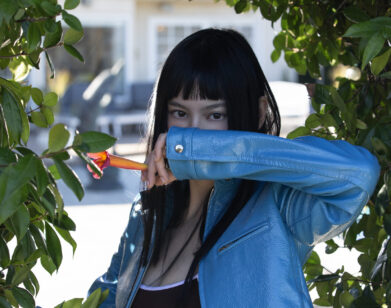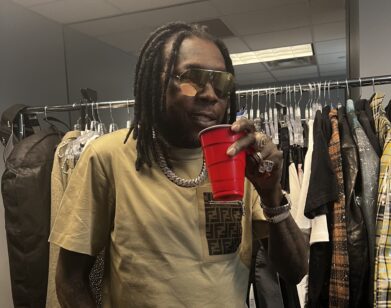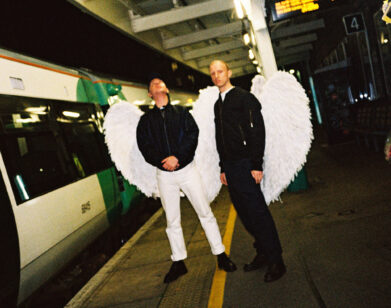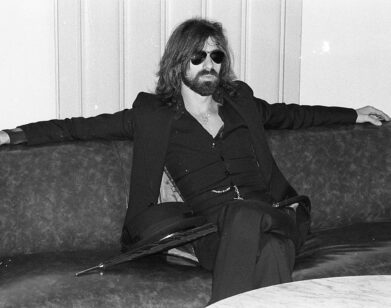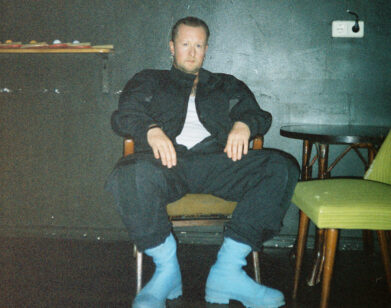When Joan Met Benjamin

ABOVE: JOAN AS POLICE WOMAN AND BENJAMIN LAZAR DAVIS. PHOTO COURTESY OF SHERVIN LAINEZ.
There’s no easy way to condense Joan As Police Woman and Benjamin Lazar Davis into a collective entity. Perhaps this is due to their respective bodies of work, in which each has produced and collaborated extensively with multiple artists across genre lines. The former, Joan Wasser, has worked with musicians such as Anohni (Antony and The Johnsons), Rufus Wainwright, Lou Reed, and Jeff Buckley, in addition to releasing four widely praised albums under her moniker (with a fifth in the works). The latter, Davis, is a multi-instrumentalist singer-songwriter, arranger, and producer, who currently performs with Okkervil River, Cuddle Magic, and Bridget Kearney. Davis’ influences range from rock and pop to West African music, which he studied at the New England Conservatory and used as inspiration for Bawa, an EP he and Kearney recorded in Ghana.
As a result, the duo form—and are informed by—a sonic pool that transcends genre and geography. In 2013, when Wasser and Davis met, they bonded over a mutual fascination with Central African Republic Pygmy music. Those sounds inform their eclectic, energetic, catchy but complex forthcoming 10-track record, Let It Be You (out October 21 via Reveal Records). Here, we’re pleased to premiere its track “Magic Lamp,” which follows the pair’s two music videos for their synth-pop-esque tracks “Overloaded” and “Broke Me In Two,” both of which star Fred Armisen and are set in a Bushwick auto repair shop.
Interview recently caught up with Wasser and Davis over the phone; Wasser was in her Brooklyn apartment, and Davis was in the back of a van headed to North Carolina. We spoke about flute ostinatos, their matching jumpsuits, and Let It Be You.
PIMPLOY PHONGSIRIVECH: Let It Be You will be released in less than a month. How are you both?
JOAN WASSER: Excited. Very excited.
BENJAMIN LAZAR DAVIS: I’ve never been more excited in my life.
WASSER: That sounds facetious but I know he’s being serious. I feel the same.
PHONGSIRIVECH: My understanding is that you two weren’t friends before you met and decided to collaborate. How did that happen?
DAVIS: Joan came to a show of mine where I was opening for this band that was a friend of hers called Sex Mob. My band Cuddle Magic was playing and I noticed her after our set because I had heard her record Real Life, which my roommate played for me some years before. I introduced myself and I think she really enjoyed the show and my set because … I do these really long count offs to get in the vibe of the music and I think that kind of left a mark on her. And so I was like, “Let’s do some co-writing sometime.” And then the rest is history.
PHONGSIRIVECH: You’ve both worked widely with other artists. What was different with this collaboration?
WASSER: It felt very natural from the start. It felt very open and unafraid, which is what I’m always looking for but is very hard to find because it’s a very vulnerable position, writing with someone else. Especially with someone you don’t know very well. Working with Ben, I felt that immediately. We seemed to really attach to similar kinds of things like really tight rhythmic ideas. It also turned out that Ben had been listening to tracks of [Central African Republic] Pygmy flute music that I had also listened to some years back. He played one of those for me and said, “I’ve been listening to this for my whole life, pretty much.” I said I wanted to learn it as well so then he taught it to me and we started writing songs and ostinatos.
DAVIS: I think it was just magical. Joan’s energy is great and rubs off on people that she’s around. The first two songs we wrote … they just flew by and it was like, wow, this is an incredible connection.
PHONGSIRIVECH: Can either of you speak a bit about the name of the record?
WASSER: It’s one of the songs on the album… [laughs] I don’t know how to answer this. I started talking and then I was like, “Hold on.”
PHONGSIRIVECH: Does that track [“Let It Be You”] kind of capture the sound of the album?
WASSER: It definitely is representative of six of the ten songs on the record where we did use Pygmy ostinatos as the basis to writing the song. If you hear that pattern that starts at the top, it goes pretty much throughout. The energy really came out on that track. It’s ecstatic, high-energy writing. Help me, Ben.
DAVIS: Yeah! There’s kind of a few of these Pygmy ostinatos that I knew of already—the ones which were in “Overloaded“ and “Broke Me In Two.” Once we ran out of those, I was kind of on a search for more, so I went to the library, I scanned [through] YouTube and at one point there were all these tracks. I think they might’ve taken some down, but [there] was a whole 45-minute long YouTube video and before I went to sleep I would just put on a whole hour of Pygmy music and I’d wake up and be like, “Oh my god. We have to say this.” I’d write it down, the musical notation. This one [for “Let It Be You“], I think I was out of town, so I sent a photograph of the written note version of the ostinato to my roommate Ryan Dugre who plays guitar on the record. He recorded the ostinato on guitar, a loop of it, and then I told him to email it to Joan. Joan worked on it from there and we ended up finishing it together. Anyway, that’s the story of the song for me.
WASSER: [laughs] I bet you weren’t ready for that.
PHONGSIRIVECH: [laughs] I guess it emerged out of your reverie.
WASSER: Definitely. The songs that we wrote that don’t have those patterns … Most of them we wrote imagining that kind of idea. We do have an extreme love and obsession really for music in general, and that’s also why I feel like Ben and I work really well together. We’re pretty, like, [shouts] “All in!” You know?
DAVIS: I was just going to say that as far as my feelings for Pygmy music goes … in my mind I feel that it’s most similar to some of the oldest music that’s ever existed because it generally is just vocals, drums, handclaps, or a one-note flute. That connected me to it in some weird way that makes me feel really at peace.
PHONGSIRIVECH: The video for “Overloaded” is impressive. Where did the idea for that come from?
WASSER: I think the video began with Ben’s blue jumpsuit. Ben was in Ghana and saw a gentleman with that jumpsuit on and went up to him and said, “I love your jumpsuit. Want to trade clothes?” And so they did. [laughs] Ben pretty much wore that nonstop. It fit him perfectly and it’s a beautiful piece of art. I happened to have almost the same one so we thought, “How could we get this jumpsuit into a video where it makes sense?” It was like, “Ok, well, we have to be car mechanics. Obviously.”
PHONGSIRIVECH: Obviously.
WASSER: [laughs] And it grew from there. Do you have more on that Ben?
DAVIS: Just that we ended up using this garage that Joan uses called Galaxy Motors. Joan has an old police car, a black and white, and she takes it to get serviced at the garage that we shot in. Joan is also old friends with Fred Armisen—
WASSER: We played in a band [Those Bastard Souls] together.
DAVIS: Yeah. Anyway, so Joan’s old friends with him and it all came together. The jumpsuit, the mechanic shop, and Fred Armisen.
PHONGSIRIVECH: You used to call yourselves 2001. What happened?
DAVIS: When we first got together, we came up with that name for our collaboration. At a certain point we just realized that this is a better representation of what this project is. It felt more honest than this random name. It just didn’t feel like it was as meaningful as just our names that we’ll always be known as for the rest of our lives.
LET IT BE YOU (REVEAL RECORDS) WILL BE RELEASED OCTOBER 21, 2016. FOR MORE ON JOAN AS POLICE WOMAN AND BENJAMIN LAZAR DAVIS, VISIT THEIR FACEBOOK.

